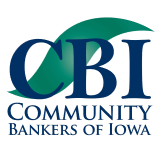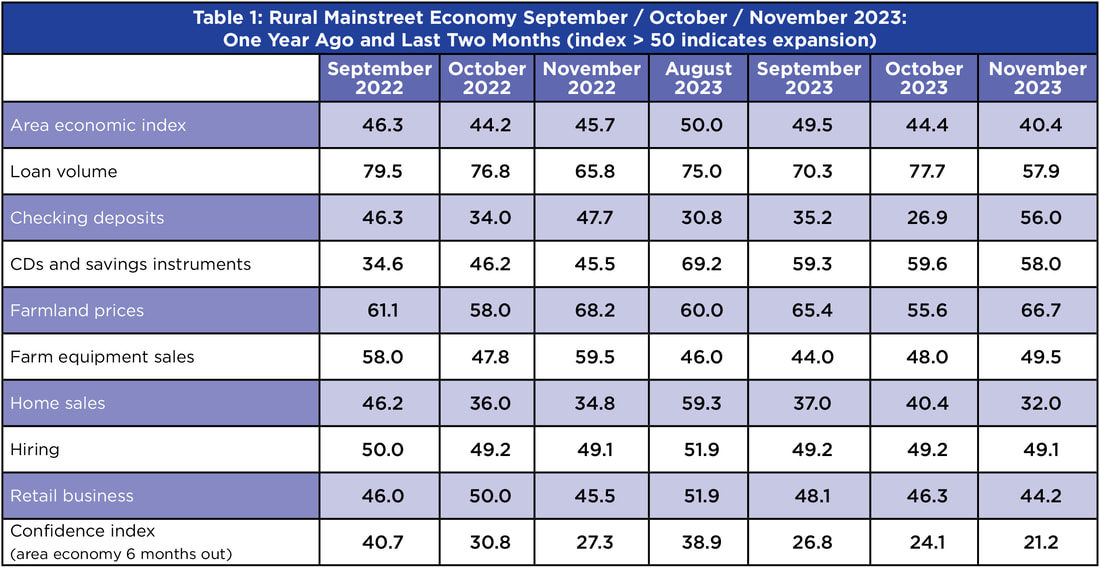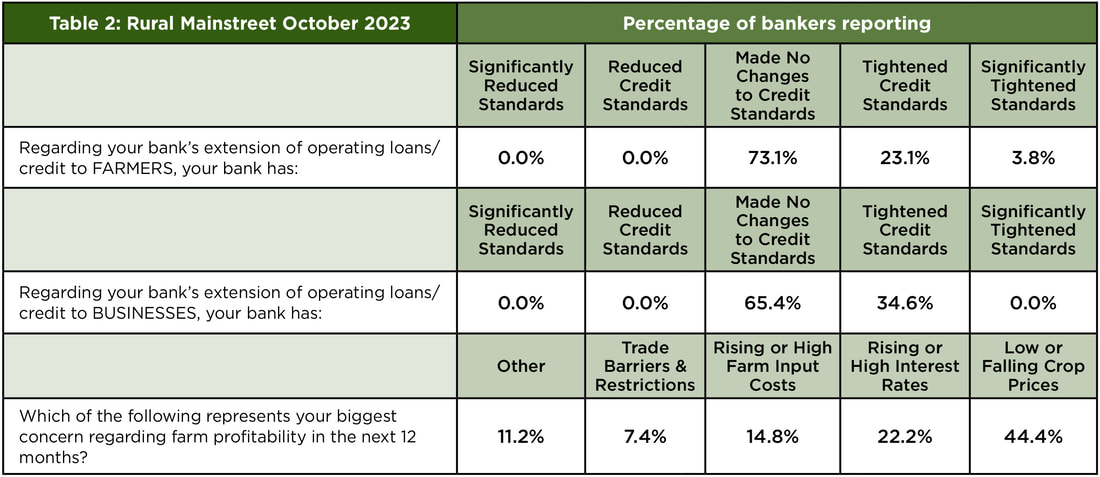- For a second straight month, the overall Rural Mainstreet Index sank below growth neutral to a 2023 low.
- For the fourth time in the past five months, farm equipment sales declined.
- Approximately 26.9% of bankers have tightened credit standards for farm borrowers.
- Approximately 34.5% of bank CEOs have tightened credit standards for business borrowers.
- Roughly 44.4% of bankers named low or falling crop prices as their top concern regarding farm profitability in the next 12 months.
- Rising or high interest rates were identified by 22.2% of bank CEOs as the greatest concern regarding farm profitability in the next 12 months.
- Checking deposits fell to their lowest level since May of this year.
Overall: The region’s overall reading for October fell to 44.4 from September’s 49.5. The index ranges between 0 and 100, with a reading of 50.0 representing growth neutral.
“This is the weakest recorded reading for 2023 and points to weaker farm and non-farm economies. Despite this weakness, only 26.8% of banks reported tightening credit standards for farmers while 34.5% indicated that their bank had tightened credits standards for businesses in their area,” said Ernie Goss, PhD, Jack A. MacAllister Chair in Regional Economics at Creighton University’s Heider College of Business.
Farm Equipment Sales: The farm equipment-sales index for October increased slightly to a weak 48.0 from September’s 44.0. “This is the fourth time the past five months that the index has fallen below growth neutral. Higher borrowing costs are having a negative impact on the purchases of farm equipment,” said Goss.
“For a second consecutive month, several bankers voiced concerns over economic losses of pork producers in their area,” said Goss.
Jim Eckert, CEO of Anchor State Bank in Anchor, Ill. said that, “Harvest is well under way in our area. Yields appear to be equal or better than 2022, despite drought conditions in July.”
Jeff Bonnett, president of Havana National Bank in Havana, Ill., “ Regarding the top farm challenge for the next 12 months, it is really the combination of higher interest rates, lower crop prices, high input costs and trade barriers. It would seem that the perfect storm is beginning to fester up.”
Banking: The October loan volume index climbed to strong 77.7 from September’s 70.3. The checking deposit index slumped to very weak 26.9 as an increasing number of depositors sought higher rates of return outside of banking. On the other hand, the index for certificates of deposits and other savings instruments increased to 59.6 from 59.3 in September.
“Higher short-term interest rates produced by Federal Reserve rate hikes over the past year continue to pose a significant threat to community banks by expanding the costs of customer deposits while the rates on bank loans have not risen as significantly over the same time period,” said Goss.
Bankers were asked the greatest challenge to farming profitability over the next 12 months. Approximately:
- 44.4% named low or falling crop prices.
- 22.2% identified rising or high interest rates.
- 14.8% registered rising or high farm input costs.
- 7.4% reported trade barriers and trade restrictions.
- The remaining 11.2% named other factors such as low hog prices and marketing of crops.
- Despite higher interest rates, no bankers identified farm loan bankruptcies.
James Brown, CEO of Hardin County Savings in Eldora, Iowa reported that, “Crop yields so far are above expectations considering the lack of moisture. Genetics are working well.”
Hiring: The new hiring index for October was unchanged from September’s 49.2. Despite these weaker readings, rural areas in the region continue to experience a healthier job market than urban areas in the same 10 states.
Confidence: Higher interest rates, deposit outflows and a rising regulatory environment continued to constrain the business confidence index to a much weaker 24.1 from 26.8 in September. “This month’s reading is the most negative outlook recorded since May 2020. Over the past 12 months, the regional confidence index has fallen to levels indicating a very negative outlook,” said Goss.
“Approximately 51.9% of bankers expect economic conditions to worsen in the next six months,” said Goss.
Home and Retail Sales: Both home sales and retail sales sank below growth neutral for October. The October home-sales index increased to 40.4 from 37.0 in September. “Higher mortgage rates are beginning to sink home sales in rural areas,” said Goss.
The retail-sales index for October dropped to 46.3 from 48.1 in September. “High consumer debt and elevated interest rates are cutting into retail sales,” said Goss.
| Colorado: Colorado’s RMI for October declined to a strong 75.4 from 79.1 in September. The farmland- and ranchland-price index for October fell to 63.1 from September’s 72.2. The state’s new hiring index decreased to 57.8 from 59.2 in September. According to U.S. BLS data, the state’s Rural Mainstreet Economy has expanded employment by 7.8% over the past 12 months, compared to a lower 0.6% for urban areas of the state for the same period-of-time. Illinois: The October RMI for Illinois declined to 49.5 from September’s 53.2. The farmland-price index dropped to 55.8 from 64.9 in September. The state’s new-hiring index was unchanged from September’s 50.1. According to U.S. BLS data, the state’s Rural Mainstreet Economy has expanded employment by 2.5% over the past 12 months, compared to a lower 0.9% for urban areas of the state for the same period-of-time. Iowa: Iowa’s October RMI increased to 43.5 from 41.4 in September. Iowa’s farmland-price index for October slumped to 45.9 from September’s 61.5. Iowa’s new-hiring index for October dropped to 44.2 from 45.9 in September. According to U.S. BLS data, the state’s Rural Mainstreet Economy has expanded employment by 0.8% over the past 12 months, compared to a higher 1.4% for urban areas of the state for the same period-of-time. Terry Engelken, vice-president and lender at Washington State Bank in Wash. reported that, “Corn and Soybean yields are higher than most farmers expected, considering we are in a drought area.” Kansas: The Kansas RMI for October fell to 45.0 from September’s 48.7. The state’s farmland-price index declined to 54.5 from 63.6 in September. The new-hiring index for Kansas improved to 50.1 from September’s 48.5. According to U.S. BLS data, the state’s Rural Mainstreet Economy has expanded employment by 1.1% over the past 12 months, compared to a higher 1.2% for urban areas of the state for the same period-of-time. Minnesota: The October RMI for Minnesota sank to 37.9 from September’s 41.6. Minnesota’s farmland-price index declined to 52.5 from 60.2 in September. The new-hiring index for October fell to 45.1 from September’s 46.0. According to U.S. BLS data, the state’s Rural Mainstreet Economy has contracted employment by 0.2% over the past 12 months, compared to an expansion of 2.0% for urban areas of the state for the same period-of-time. | Missouri: The state’s October RMI declined to 36.5 from 40.2 in September. The farmland-price index dropped to 52.1 from 61.2 in September. The state’s new hiring gauge decreased to 44.1 from 45.5 in September. According to U.S. BLS data, the state’s Rural Mainstreet Economy has contracted employment by 0.6% over the past 12 months, compared to an expansion of 2.1% for urban areas of the state for the same period-of-time. Nebraska: The Nebraska RMI for October fell to 44.3 from 48.0 in September. The state’s farmland-price index for October declined to 54.3 from 63.4 in September. Nebraska’s October new-hiring index increased to 49.8 from September’s 48.3. According to U.S. BLS data, the state’s Rural Mainstreet Economy has expanded employment by 1.2% over the past 12 months, compared to a higher 1.4% for urban areas of the state for the same period-of-time. North Dakota: North Dakota’s RMI for October decreased to 58.5 from 62.2 in September. The state’s farmland-price index dropped to 58.4 from 67.4 in September. The state’s new-hiring index rose to 53.9 from September’s 53.2. According to U.S. BLS data, the state’s Rural Mainstreet Economy has expanded employment by 3.4% over the past 12 months, compared to a lower 0.9% for urban areas of the state for the same period-of-time. South Dakota: The October RMI for South Dakota declined to 42.2 from 45.9 in September. The state’s farmland-price index decreased to 53.7 from 62.8 in September. South Dakota’s October new-hiring index sank to 46.2 from 47.5 in September. According to U.S. BLS data, the state’s Rural Mainstreet Economy has expanded employment by 2.0% over the past 12 months, compared to a lower 1.9% for urban areas of the state for the same period-of-time. Wyoming: The October RMI for Wyoming decreased to 52.5 from September’s 54.7. The October farmland- and ranchland-price index decreased to 56.7 from 65.7 in September. Wyoming’s new-hiring index rose to 51.3 from September’s 51.1. According to U.S. BLS data, the state’s Rural Mainstreet Economy has expanded employment by 3.2% over the past 12 months, compared to a lower 2.0% for urban areas of the state for the same period-of-time. |



 RSS Feed
RSS Feed